Songcen Xu
Noah's Ark Lab, Huawei Technologies, Shenzhen, China
MagicEraser: Erasing Any Objects via Semantics-Aware Control
Oct 14, 2024Abstract:The traditional image inpainting task aims to restore corrupted regions by referencing surrounding background and foreground. However, the object erasure task, which is in increasing demand, aims to erase objects and generate harmonious background. Previous GAN-based inpainting methods struggle with intricate texture generation. Emerging diffusion model-based algorithms, such as Stable Diffusion Inpainting, exhibit the capability to generate novel content, but they often produce incongruent results at the locations of the erased objects and require high-quality text prompt inputs. To address these challenges, we introduce MagicEraser, a diffusion model-based framework tailored for the object erasure task. It consists of two phases: content initialization and controllable generation. In the latter phase, we develop two plug-and-play modules called prompt tuning and semantics-aware attention refocus. Additionally, we propose a data construction strategy that generates training data specially suitable for this task. MagicEraser achieves fine and effective control of content generation while mitigating undesired artifacts. Experimental results highlight a valuable advancement of our approach in the object erasure task.
TexGen: Text-Guided 3D Texture Generation with Multi-view Sampling and Resampling
Aug 02, 2024Abstract:Given a 3D mesh, we aim to synthesize 3D textures that correspond to arbitrary textual descriptions. Current methods for generating and assembling textures from sampled views often result in prominent seams or excessive smoothing. To tackle these issues, we present TexGen, a novel multi-view sampling and resampling framework for texture generation leveraging a pre-trained text-to-image diffusion model. For view consistent sampling, first of all we maintain a texture map in RGB space that is parameterized by the denoising step and updated after each sampling step of the diffusion model to progressively reduce the view discrepancy. An attention-guided multi-view sampling strategy is exploited to broadcast the appearance information across views. To preserve texture details, we develop a noise resampling technique that aids in the estimation of noise, generating inputs for subsequent denoising steps, as directed by the text prompt and current texture map. Through an extensive amount of qualitative and quantitative evaluations, we demonstrate that our proposed method produces significantly better texture quality for diverse 3D objects with a high degree of view consistency and rich appearance details, outperforming current state-of-the-art methods. Furthermore, our proposed texture generation technique can also be applied to texture editing while preserving the original identity. More experimental results are available at https://dong-huo.github.io/TexGen/
EmoTalk3D: High-Fidelity Free-View Synthesis of Emotional 3D Talking Head
Aug 01, 2024



Abstract:We present a novel approach for synthesizing 3D talking heads with controllable emotion, featuring enhanced lip synchronization and rendering quality. Despite significant progress in the field, prior methods still suffer from multi-view consistency and a lack of emotional expressiveness. To address these issues, we collect EmoTalk3D dataset with calibrated multi-view videos, emotional annotations, and per-frame 3D geometry. By training on the EmoTalk3D dataset, we propose a \textit{`Speech-to-Geometry-to-Appearance'} mapping framework that first predicts faithful 3D geometry sequence from the audio features, then the appearance of a 3D talking head represented by 4D Gaussians is synthesized from the predicted geometry. The appearance is further disentangled into canonical and dynamic Gaussians, learned from multi-view videos, and fused to render free-view talking head animation. Moreover, our model enables controllable emotion in the generated talking heads and can be rendered in wide-range views. Our method exhibits improved rendering quality and stability in lip motion generation while capturing dynamic facial details such as wrinkles and subtle expressions. Experiments demonstrate the effectiveness of our approach in generating high-fidelity and emotion-controllable 3D talking heads. The code and EmoTalk3D dataset are released at https://nju-3dv.github.io/projects/EmoTalk3D.
GSD: View-Guided Gaussian Splatting Diffusion for 3D Reconstruction
Jul 05, 2024Abstract:We present GSD, a diffusion model approach based on Gaussian Splatting (GS) representation for 3D object reconstruction from a single view. Prior works suffer from inconsistent 3D geometry or mediocre rendering quality due to improper representations. We take a step towards resolving these shortcomings by utilizing the recent state-of-the-art 3D explicit representation, Gaussian Splatting, and an unconditional diffusion model. This model learns to generate 3D objects represented by sets of GS ellipsoids. With these strong generative 3D priors, though learning unconditionally, the diffusion model is ready for view-guided reconstruction without further model fine-tuning. This is achieved by propagating fine-grained 2D features through the efficient yet flexible splatting function and the guided denoising sampling process. In addition, a 2D diffusion model is further employed to enhance rendering fidelity, and improve reconstructed GS quality by polishing and re-using the rendered images. The final reconstructed objects explicitly come with high-quality 3D structure and texture, and can be efficiently rendered in arbitrary views. Experiments on the challenging real-world CO3D dataset demonstrate the superiority of our approach.
AutoTVG: A New Vision-language Pre-training Paradigm for Temporal Video Grounding
Jun 11, 2024Abstract:Temporal Video Grounding (TVG) aims to localize a moment from an untrimmed video given the language description. Since the annotation of TVG is labor-intensive, TVG under limited supervision has accepted attention in recent years. The great success of vision-language pre-training guides TVG to follow the traditional "pre-training + fine-tuning" paradigm, however, the pre-training process would suffer from a lack of temporal modeling and fine-grained alignment due to the difference of data nature between pre-train and test. Besides, the large gap between pretext and downstream tasks makes zero-shot testing impossible for the pre-trained model. To avoid the drawbacks of the traditional paradigm, we propose AutoTVG, a new vision-language pre-training paradigm for TVG that enables the model to learn semantic alignment and boundary regression from automatically annotated untrimmed videos. To be specific, AutoTVG consists of a novel Captioned Moment Generation (CMG) module to generate captioned moments from untrimmed videos, and TVGNet with a regression head to predict localization results. Experimental results on Charades-STA and ActivityNet Captions show that, regarding zero-shot temporal video grounding, AutoTVG achieves highly competitive performance with in-distribution methods under out-of-distribution testing, and is superior to existing pre-training frameworks with much less training data.
MirrorGaussian: Reflecting 3D Gaussians for Reconstructing Mirror Reflections
May 20, 2024



Abstract:3D Gaussian Splatting showcases notable advancements in photo-realistic and real-time novel view synthesis. However, it faces challenges in modeling mirror reflections, which exhibit substantial appearance variations from different viewpoints. To tackle this problem, we present MirrorGaussian, the first method for mirror scene reconstruction with real-time rendering based on 3D Gaussian Splatting. The key insight is grounded on the mirror symmetry between the real-world space and the virtual mirror space. We introduce an intuitive dual-rendering strategy that enables differentiable rasterization of both the real-world 3D Gaussians and the mirrored counterpart obtained by reflecting the former about the mirror plane. All 3D Gaussians are jointly optimized with the mirror plane in an end-to-end framework. MirrorGaussian achieves high-quality and real-time rendering in scenes with mirrors, empowering scene editing like adding new mirrors and objects. Comprehensive experiments on multiple datasets demonstrate that our approach significantly outperforms existing methods, achieving state-of-the-art results. Project page: https://mirror-gaussian.github.io/.
The Ninth NTIRE 2024 Efficient Super-Resolution Challenge Report
Apr 16, 2024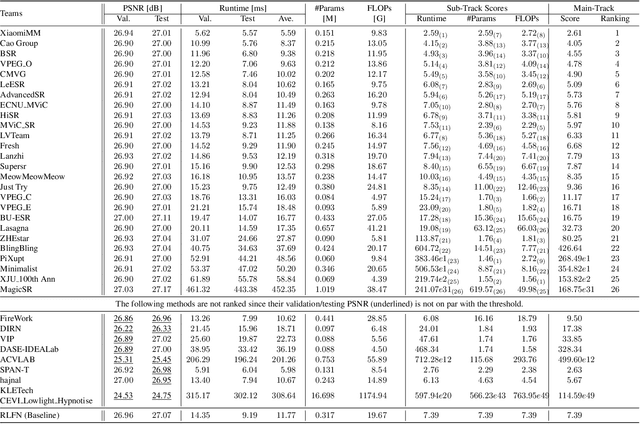
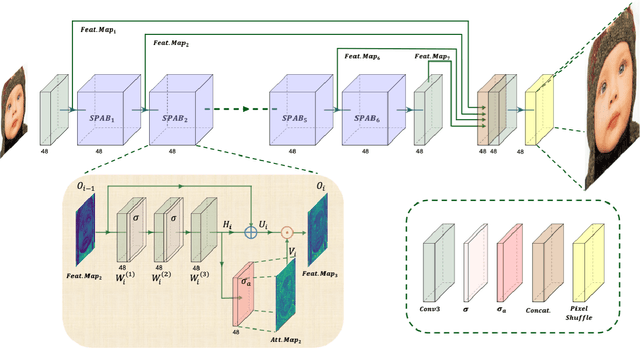


Abstract:This paper provides a comprehensive review of the NTIRE 2024 challenge, focusing on efficient single-image super-resolution (ESR) solutions and their outcomes. The task of this challenge is to super-resolve an input image with a magnification factor of x4 based on pairs of low and corresponding high-resolution images. The primary objective is to develop networks that optimize various aspects such as runtime, parameters, and FLOPs, while still maintaining a peak signal-to-noise ratio (PSNR) of approximately 26.90 dB on the DIV2K_LSDIR_valid dataset and 26.99 dB on the DIV2K_LSDIR_test dataset. In addition, this challenge has 4 tracks including the main track (overall performance), sub-track 1 (runtime), sub-track 2 (FLOPs), and sub-track 3 (parameters). In the main track, all three metrics (ie runtime, FLOPs, and parameter count) were considered. The ranking of the main track is calculated based on a weighted sum-up of the scores of all other sub-tracks. In sub-track 1, the practical runtime performance of the submissions was evaluated, and the corresponding score was used to determine the ranking. In sub-track 2, the number of FLOPs was considered. The score calculated based on the corresponding FLOPs was used to determine the ranking. In sub-track 3, the number of parameters was considered. The score calculated based on the corresponding parameters was used to determine the ranking. RLFN is set as the baseline for efficiency measurement. The challenge had 262 registered participants, and 34 teams made valid submissions. They gauge the state-of-the-art in efficient single-image super-resolution. To facilitate the reproducibility of the challenge and enable other researchers to build upon these findings, the code and the pre-trained model of validated solutions are made publicly available at https://github.com/Amazingren/NTIRE2024_ESR/.
Co-Speech Gesture Video Generation via Motion-Decoupled Diffusion Model
Apr 02, 2024
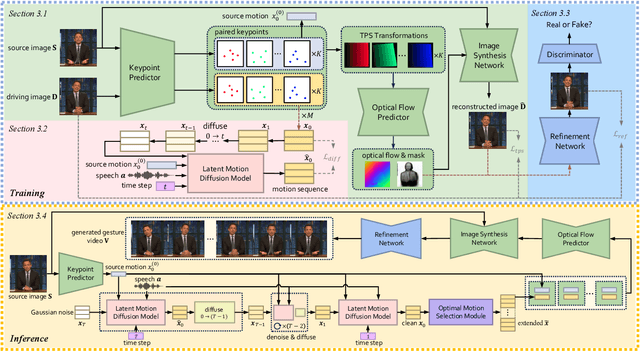

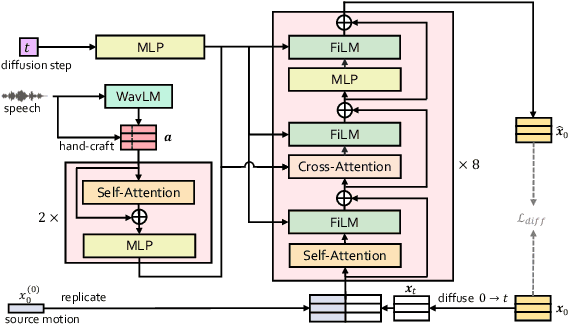
Abstract:Co-speech gestures, if presented in the lively form of videos, can achieve superior visual effects in human-machine interaction. While previous works mostly generate structural human skeletons, resulting in the omission of appearance information, we focus on the direct generation of audio-driven co-speech gesture videos in this work. There are two main challenges: 1) A suitable motion feature is needed to describe complex human movements with crucial appearance information. 2) Gestures and speech exhibit inherent dependencies and should be temporally aligned even of arbitrary length. To solve these problems, we present a novel motion-decoupled framework to generate co-speech gesture videos. Specifically, we first introduce a well-designed nonlinear TPS transformation to obtain latent motion features preserving essential appearance information. Then a transformer-based diffusion model is proposed to learn the temporal correlation between gestures and speech, and performs generation in the latent motion space, followed by an optimal motion selection module to produce long-term coherent and consistent gesture videos. For better visual perception, we further design a refinement network focusing on missing details of certain areas. Extensive experimental results show that our proposed framework significantly outperforms existing approaches in both motion and video-related evaluations. Our code, demos, and more resources are available at https://github.com/thuhcsi/S2G-MDDiffusion.
Self-Adaptive Reality-Guided Diffusion for Artifact-Free Super-Resolution
Mar 25, 2024

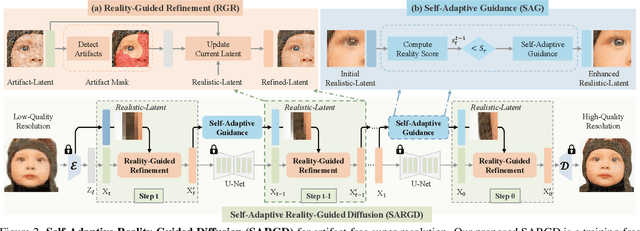
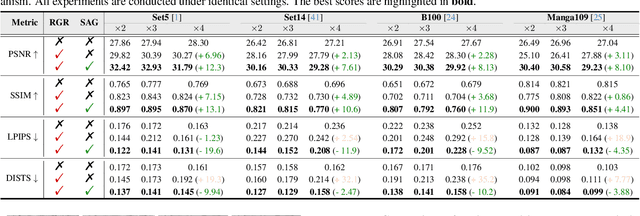
Abstract:Artifact-free super-resolution (SR) aims to translate low-resolution images into their high-resolution counterparts with a strict integrity of the original content, eliminating any distortions or synthetic details. While traditional diffusion-based SR techniques have demonstrated remarkable abilities to enhance image detail, they are prone to artifact introduction during iterative procedures. Such artifacts, ranging from trivial noise to unauthentic textures, deviate from the true structure of the source image, thus challenging the integrity of the super-resolution process. In this work, we propose Self-Adaptive Reality-Guided Diffusion (SARGD), a training-free method that delves into the latent space to effectively identify and mitigate the propagation of artifacts. Our SARGD begins by using an artifact detector to identify implausible pixels, creating a binary mask that highlights artifacts. Following this, the Reality Guidance Refinement (RGR) process refines artifacts by integrating this mask with realistic latent representations, improving alignment with the original image. Nonetheless, initial realistic-latent representations from lower-quality images result in over-smoothing in the final output. To address this, we introduce a Self-Adaptive Guidance (SAG) mechanism. It dynamically computes a reality score, enhancing the sharpness of the realistic latent. These alternating mechanisms collectively achieve artifact-free super-resolution. Extensive experiments demonstrate the superiority of our method, delivering detailed artifact-free high-resolution images while reducing sampling steps by 2X. We release our code at https://github.com/ProAirVerse/Self-Adaptive-Guidance-Diffusion.git.
LayerDiff: Exploring Text-guided Multi-layered Composable Image Synthesis via Layer-Collaborative Diffusion Model
Mar 18, 2024Abstract:Despite the success of generating high-quality images given any text prompts by diffusion-based generative models, prior works directly generate the entire images, but cannot provide object-wise manipulation capability. To support wider real applications like professional graphic design and digital artistry, images are frequently created and manipulated in multiple layers to offer greater flexibility and control. Therefore in this paper, we propose a layer-collaborative diffusion model, named LayerDiff, specifically designed for text-guided, multi-layered, composable image synthesis. The composable image consists of a background layer, a set of foreground layers, and associated mask layers for each foreground element. To enable this, LayerDiff introduces a layer-based generation paradigm incorporating multiple layer-collaborative attention modules to capture inter-layer patterns. Specifically, an inter-layer attention module is designed to encourage information exchange and learning between layers, while a text-guided intra-layer attention module incorporates layer-specific prompts to direct the specific-content generation for each layer. A layer-specific prompt-enhanced module better captures detailed textual cues from the global prompt. Additionally, a self-mask guidance sampling strategy further unleashes the model's ability to generate multi-layered images. We also present a pipeline that integrates existing perceptual and generative models to produce a large dataset of high-quality, text-prompted, multi-layered images. Extensive experiments demonstrate that our LayerDiff model can generate high-quality multi-layered images with performance comparable to conventional whole-image generation methods. Moreover, LayerDiff enables a broader range of controllable generative applications, including layer-specific image editing and style transfer.
 Add to Chrome
Add to Chrome Add to Firefox
Add to Firefox Add to Edge
Add to Edge